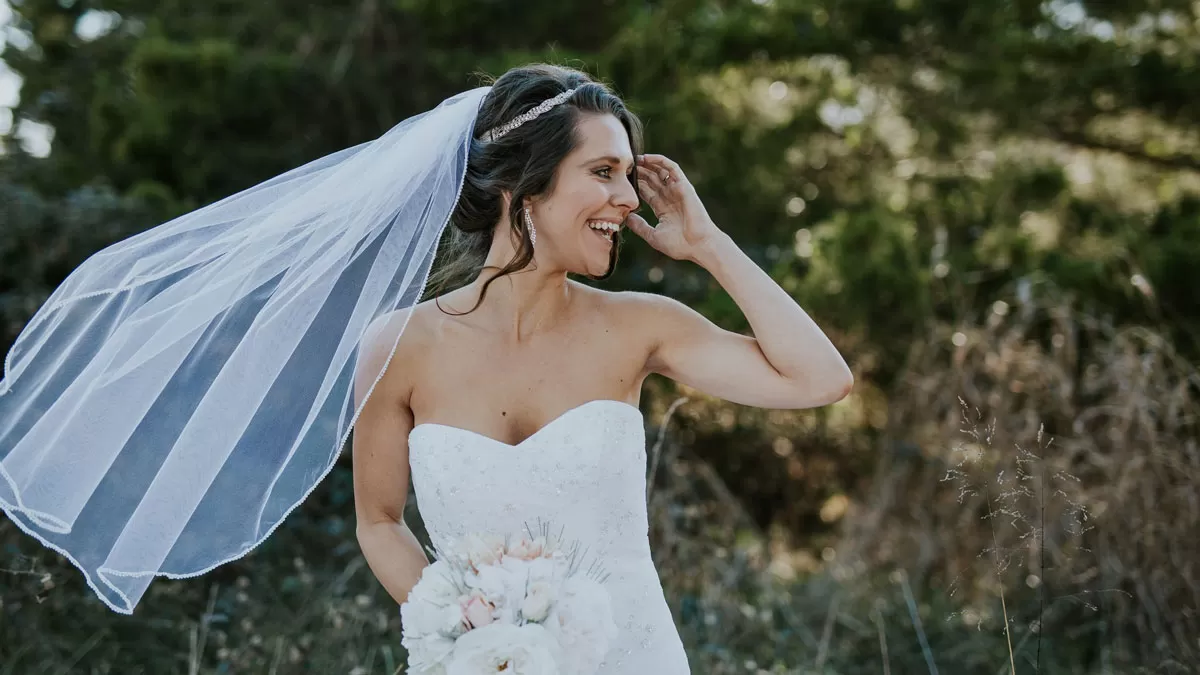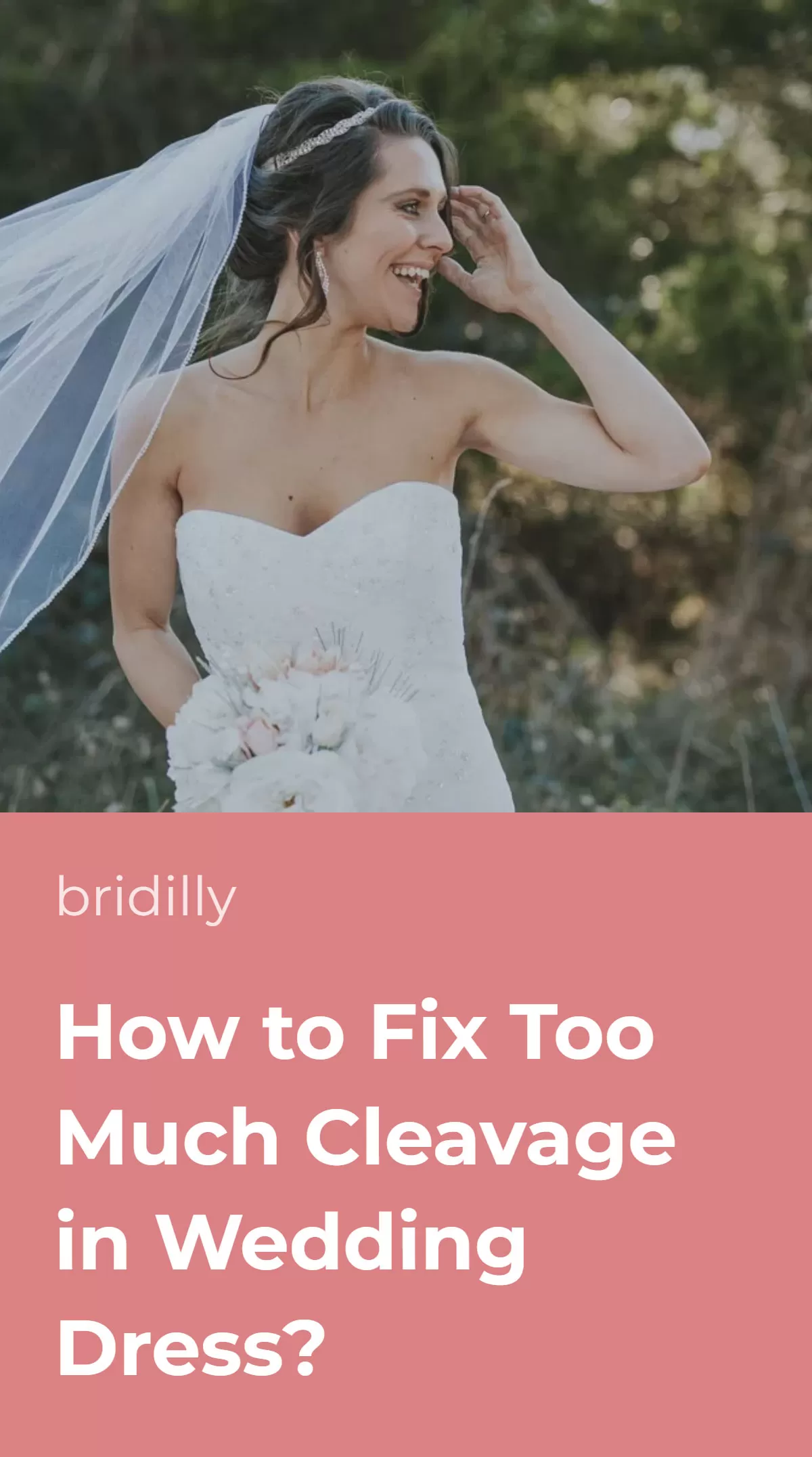Everyone’s bust and perception of appropriateness are different, so wondering how to cover cleavage in a wedding dress isn’t uncommon among brides.
While most women have no issue wearing plunging necklines casually, even the most daring of us may find them excessive in wedding dresses.
Showing a bit of cleavage is a classic look, but how much is “a bit”? Understanding whether your wedding dress neckline is too low can be tricky without a second opinion.
The good news is that you have multiple solutions to choose from. You can fix too much cleavage by adding a modesty panel, shortening straps, changing the bra, or altering the neckline.
Most importantly, you should feel comfortable and confident in your wedding dress. There’s no need to cover up if someone says your cleavage is too low while you find it appropriate, and vice versa.
Table of Contents [show]
How Low Is Too Low?
First, you should understand how excessive your dress’ cleavage is. Weddings are typically considered solemn, formal affairs, but no ceremony is the same. A church ceremony and laid-back beach wedding have different dress codes.
As a rule of thumb, the wedding dress’ cleavage shouldn’t be lower than two inches, three inches at most. Consider an even more modest neckline for a church ceremony, showing an inch of the bust or less.
However, it also depends on the overall dress style. If your dress is a traditional A-line or empire that doesn’t hug the curves, showing a bit more cleavage won’t hurt anyone.
On the other hand, mermaid gowns or dresses with thigh slits are seductive enough, so you’d want to keep the neckline modest.
Another factor affecting how appropriate your dress’ cleavage looks is your bust size.
Although it’s unfair, women with smaller busts have more freedom in necklines than women with larger busts because the latter draw more attention even in modest gowns.
In other words, if you’re wearing a cup D bra, refrain from a plunging neckline for your wedding because your attire may look too provocative. Meanwhile, women with cup A can look classy even with an extra-deep V-cut.
You may also listen to your partner’s and family’s opinions. Of course, no one can dictate what to wear at your wedding, but if your partner or parents find your cleavage inappropriate, consider covering up.
On the opposite, others may find your dress’ cleavage not as excessive as you do. Ask for a second opinion to find out whether you’re worrying for no reason.
Add a Fabric Panel
An easy way to fix too much cleavage in a wedding dress is by adding a fabric panel, also called a modesty panel. This trick works the best with plunging V-cut and sweetheart necklines.
A modesty panel is usually a small triangle piece of fabric sewn onto the dress’ inner part. Depending on how much cleavage you need to fix and your desired look, you can use semi-sheer tulle or opaque fabric.
Sometimes, lace works better than regular fabric, adding a modern touch to the neckline. Alternatively, you may add a sheer illusion modesty panel and embellish it.
You can add a modesty panel yourself if you don’t have the time or money for professional alterations but have basic sewing skills. First, you’ll need to find suitable fabric and thread that matches your dress color.
Then, try on your dress and mark how high you want the modesty panel to end with sewing pins. Take the dress off and measure the necessary modesty panel size according to your marked points.
Draw a pattern of the necessary size on paper, then trace the pattern onto the fabric with about half an inch of the seam allowance.
Depending on the fabric, you may need to mirror the pattern to fold the panel after cutting it out for a neat edge. Pin it to your dress’s neckline from the inner side after you cut out the fabric and sew it on.
Change the Bra
The provocative cleavage problem often lies in the bra. Although a bra won’t make your dress’ neckline lower or higher, it affects how appropriate your cleavage looks.
The golden rule is – the bra shouldn’t smash your breasts together. That’s a common problem with super push-up bras intended to make your bust two or three sizes larger.
Cleavage in a plunging neckline dress should look natural, so your breast shouldn’t touch.
Google “Victoria’s Secret fashion show 2003, Heidi Klum” to understand which look you want to avoid. It’s appropriate for a lingerie fashion show, but not for a wedding.
For an example of an appropriate cleavage look, search for “Victoria’s Secret fashion show 2013, Candice Swanepoel.” You should now get the idea. Strive for a delicate cleavage that doesn’t resemble a poorly done enhancement surgery.
The correct bra should lift your breasts but not push them together. Avoid super push-up bras and opt for a classic underwire T-shirt or balconette bra.
If you really want to make your bust appear larger by wearing a push-up, have it professionally sized. The correct sizing will ensure an appropriate look without bumps and lumps or free space between the skin and bra cups.
In some cases, it’s best to ditch the bra entirely. You can add bust inserts to your wedding dress for extra support or wear nipple covers instead.
Shorten the Straps
Sometimes, excessive wedding dress cleavage can be easily fixed by shortening the straps. The fabric can droop at the neckline when the straps are too long, creating an overly deep cleavage effect.
If you have a spaghetti strap or sleeveless V-neck dress, try it on and push up the straps. If the cleavage looks better, bring your gown to a sewist or shorten the straps yourself.
The price of shortening wedding dress straps ranges from $20 to $60 on average. This isn’t a high price for ensuring your dress fits flawlessly and is appropriate for the occasion.
Sew the Sides Together
Shortening the straps doesn’t always help, and a fabric panel can drastically alter the dress’ look. You can sew the neckline sides together if you wish to maintain the neckline cut but make the cleavage more modest.
Note that this method only works with V-cut and sweetheart neckline dresses. It isn’t suitable for wedding dresses with semi-sweetheart, square, or scoop necklines.
Depending on your dress design intricacy, the process can be straightforward or highly complex.
Bringing the dress to a professional sewist is always a good idea, but you may attempt DIY alterations if you have intermediate or higher sewing skills.
Beginners shouldn’t try to alter the dress neckline themselves. Unlike a modesty panel that can be easily attached or removed without consequences, even minor changes to the neckline cut can affect the entire bodice fit.
In a simple case, such neckline alteration may cost you under $30. In complex cases, the cost of wedding dress neckline alterations may exceed $100.
Furthermore, many wedding dresses have embellishments that must be removed before alterations and sewn back afterward. Expect to pay about $30 per hour of beading work.
Illusion Neckline
One of the best ways to fix cleavage in a wedding dress is by adding an illusion neckline and sleeves. This method works with virtually any bodice style and can make your dress even more beautiful.
Illusion sleeves provide extra arm and back coverage, concealing underarm and back fat while showcasing skin. They ensure your cleavage looks appropriate but leave room for imagination.
Illusion neckline and sleeves are made from transparent mesh creating a barely-there effect with strategically located lace appliques or beading. This style is an excellent way to fix cleavage while drawing attention to the upper body.
Choose a sleeveless or short-sleeve illusion neckline for a summer or spring wedding and three-quarter or long illusion sleeves for a fall or winter affair.
Note that this method is the most expensive. Adding sleeves to a wedding dress is bespoke customization that can cost you over $250.
Wear a Shawl
After all, you can always find a suitable shawl to hide your cleavage. A glamorous white faux fur shawl or cozy woven mohair wrap will keep you warm on a chilly winter day and make your bridal attire more unique.
If your wedding is planned for spring or summer, you can wear a feather boa, lightweight tulle, or viscose shawl. Most importantly, it should cover not solely the shoulders but also the cleavage.
Consider silk or lace shawls for classic aesthetics or fringed toppers for an ultimate show-stopping look. The cover doesn’t even have to be white – consider matching it to your wedding color scheme.
Alternatively, consider capes for a bohemian, royal look. Naturally, you want to find a cape covering the cleavage rather than attaching to shoulders and only covering the back.
Bridal capes come in all lengths, fabrics, and styles, from short see-through topper capes to long, intricately embellished capes from opaque materials.
They can provide delicate coverage to your shoulders and bust or serve as a fashion statement piece.













No Comments Add one
Leave a Comment